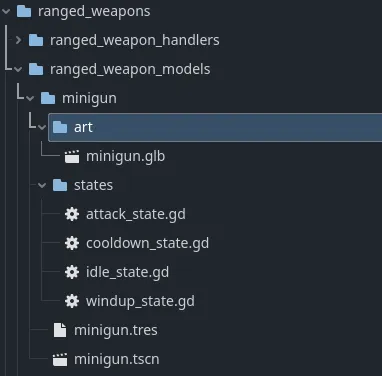Create Ranged Weapon
Ranged weapons are a bit more complicated to implement than melee weapons, but the same principles apply. The main difference is, that with ranged weapons, the state machine is on the weapon itself, rather than the player. This is done to make each ranged weapon unique, since it allows for more complex weapon mechanics.
Why This Approach?
Section titled “Why This Approach?”The ranged weapon system is structured this way for several reasons:
- Inheritance from base scene: Using inheritance ensures all ranged weapons share the same core functionality and removes some duplication.
- The
AnimationPlayercan not be put in the base scene, since each weapon needs different animations.
- The
- Standardized folder structure: Organizing weapons in dedicated subfolders keeps the project tidy and makes it easier to find and manage assets as the number of weapons grows. It also allows us to loop over the folders, so new weapons can automatically be loaded in.
- Resource-based design: Using
RangedWeaponResourceseparates the weapon’s properties from its visual side. This makes balancing easier and allows weapons to persist in save files, without complex serialization, since resources can be directly saved to disk in Godot.- Pre-saving the weapon resources as .tres files significantly improves loading times in shop inventories. This architecture makes it easy to add new weapons without modifying core game systems or needing to specify each new model location somewhere.
Folder Structure
Section titled “Folder Structure”All new ranged weapons should be placed in a new subfolder in entities/weapons/ranged_weapons/ranged_weapon_models, following the same folder structure as melee weapons, but with a states directory:

Create the ranged weapon scene
Section titled “Create the ranged weapon scene”Within the entities/weapons/ranged_weapons/ranged_weapon_models folder, there is a scene called base_ranged_weapon_model.tscn.
Step-by-step process:
Section titled “Step-by-step process:”- Create an inherited scene
- Right-click on
base_ranged_weapon_model.tscnand select “New Inherited Scene” - Save it in a new subfolder with a descriptive name (e.g.,
minigun) - Within the new subfolder, import or create an art file for the
.glb3D model - Create a new folder called
stateswithin the weapon folder- This is where the weapon’s states will be stored
AttackOriginis the node that will be used to spawn the projectile- It is important to set the position of this node correctly, since the attacks will be spawned at this position
- Right-click on
- Add required nodes to the scene
- Add the
.glbasset as a child of the root node- Scale it accordingly
- Add an
AnimationPlayernode if not already present- Create animations for the weapon states as needed
- Under the
HitAreanode, add aCollisionShape3D- Shape it to match the weapon’s striking area (e.g., barrel for guns)
- Adjust the size and position to match the visual representation
- Create a new Node under the state machine for each state (e.g.,
idle,aiming,attacking, etc.)- Save them in the
statesfolder - Make sure to set the default state in the state machine
- Should look something like:

- Save them in the
- Add the
- Configure the weapon properties
- Select the scene root node
- Assign the
AnimationPlayerto the appropriate property - Create a new
RangedWeaponResourceunder the “Current Weapon” property- Fill in the fields.
- Model UID: It is important to copy over the UID of the weapon scene, for save/load functionality
- Damage: Set the damage value for the weapon
- Range: Define the effective range of the weapon
- Fire Rate: Specify how quickly the weapon can fire
- Fill in the fields.
- Save the resource file (Recommended)
- Save the
RangedWeaponResourceas a.tresfile in the same folder- This improves shop loading performance, since loading a
.tresfile is faster than instantiating the weapon scene to get the required properties
- This improves shop loading performance, since loading a
- Save the
- Test your weapon
- Verify animations play correctly and hit detection works as expected